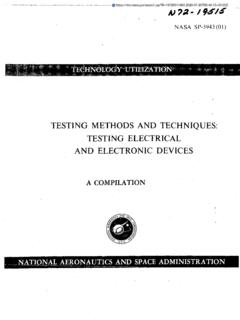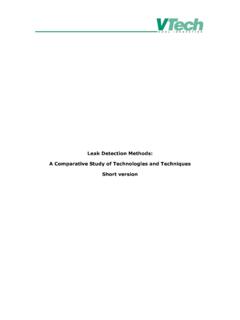Transcription of LOX/Methane In-Space Propulsion Systems Technology ... - …
1 National Aeronautics and Space In-Space Propulsion Systems Technology Status and GapsMark D. Klem NASA GRCS outhwest Emerging Technology Symposium (SETS) 2017 National Aeronautics and Space Human exploration architecture studies have identified liquid oxygen (LOX)/ methane (LCH4) as a strong candidate for both interplanetary and descent/ascent Propulsion solutions Significant research efforts into methane Propulsion have been conducted for over 50 years, ranging from fundamental combustion & mixing efforts to rocket chamber and system level demonstrations Over the past 15 years NASA and its partners have built upon these early activities that have demonstrated practical components and sub- Systems needed to field future methane space transportation elements These advanced development efforts have formed a foundation of LOX/LCH4 Propulsion knowledge that has significantly reduced the development risks of future methane based In-Space transportationBackgroundNational Aeronautics and Space Propellants Advantages and
2 Disadvantages As a bipropellant Propulsion system, LOX/LCH4 has some favorable characteristics for long life and reusability, which are critical to lunar and Mars missions Non-toxic, non-corrosive, self-venting, and simple to purge No extensive decontamination process required as with toxic propellants High vapor pressure provides for excellent vacuum ignition characteristics Performance is better than current earth storable propellants for human scale spacecraft Provides the capability for future Mars exploration missions to use propellants that are produced in-situ on Mars Liquid methane is thermally similar to O2as a cryogenic propellant, 90,111 K (LO2, LCH4 respectively)
3 Instead of the 23 K of LH2 Allows for common components and thus providing cost savings as compared to liquid hydrogen (LH2) Due to liquid methane having a 6x higher density than hydrogen, it can be stored in much smaller volumes Cryogenic storage aspect of these propellants needs to be addressed Passive techniques using shielding and orientations to deep space Refrigeration may be required to maintain both oxygen and methane in liquid formsNational Aeronautics and Space for BeyondEarth Orbit Human Exploration Some architecture studies have identified the potential for commonality between interplanetary and descent/ascent Propulsion solutions using LOX/LCH4 Meeting these functions (interplanetary, descent, and ascent Propulsion )
4 Will require many or all of the following subsystems, components, and capabilities: Reaction Control Propulsion : ~ 100 to 880 N (25 lbf 200 lbf) class Pressure fed engine: ~ 25 KN (6000 lbf) class Pump fed engine system~ 100 KN (25,000 lbf) class Long Duration Cryogenic Fluid Management and Distribution Including high performance pressurization Systems Including thermal management with high performance Multilayer insulation and 90K class cryo-cooler Systems integrated with CFM&D Including management of propellant losses due to boil-off and component leakageNational Aeronautics and Space Propulsion System Technology AreasPerformance needs for a Deep space based lander or other vehicles (service modules, tugs, etc)
5 GoalsTechnology SolutionsIntegrated SystemHigh Reliability - several usages of the same vehicle, Low cost, HIgh delta-v, long life reusable, High mass fraction, quality and origin of methane1. Reliability > Life > 10 operating cycles3. Mass Fraction > (Prop dry+structure)1. Design for re-usabilityPressurization SystemHigh density light weight storage50% reduction in volume and mass over ambient temperature storage1. Ghe cold storage with heat exchanger2. partial autogenous systemsPressure vesselLightweight1. PV/W > [Tank Pressure*volume/Tank Mass]1. Metallic (aluminum lithium)2.
6 Composite Overwrap3. All CompositeThermal Managementlow boiloff, thermodynamical management of propellants during launcher phase from Earth ground1. deep space Zero boil-off (0 W/m2) storage at EML12. lunar surface surface heat leak Watts/m21. Passive2. activeLiquid Acquistion in zero/low gzero-g start, refueling capability, slosh damping, and anti vortex1. 2% residuals1. Screens channel2. Vanes3. SpongesFeedsystemRedundancy management, propellant distribution1. Lightweight2. Low Pressure drop3. low heat leak1. Cryogenic Feedsystem for LOx/LCH4 main engine and RCSR eaction Control EnginesProvide Min.
7 Impulse Bit, Thrust, and high cycle life1. Min Ibit TBD2. Thrust Range 3. Cycle Life > TBDMain EnginesThrottle capability including idle mode, High Isp, High reliability, Thrust / Weight ratio1. > 4:1 throttle depending on T/W2. Isp > 355 sec3. Thrust >30 KN4. Helium free design1. Pump-fed,2. Pressure-fed Ablative3. Pressure-fed regenDefined Performance Needs, Goals, Solution SpaceNational Aeronautics and Space OF TECHNOLOGY6 National Aeronautics and Space -Agenzia Spaziale Italiana (ASI) Tested MIRA Demonstrator, a 100-kN (10-tonne) thrust class, expander cycle LOx/LCH4 engine, for the a new upper stage of Vega, in cooperation with Roscosmos Successfully tested at the complete engine level More than 11 tests performed up to full operating condition Accumulating more than 600 s of firing.
8 Development and testing of liquid methane fuel turbo-pump bearings With JAXA, ASI is investigating the methane thermal behavior, characterizing bearings working in liquid methane , and designing a regenerative thrust chamber in the 100-kN (10-tonne) class which is to be tested in Italy Designing small methane thrusters to be applied as a potential reaction control system of the launcher stage The Italian Aerospace Research Center, CIRA, is developing the Hyprob research program, specifically dedicated to combustion phenomena studies and breadboard testing, up to the design of a medium scale 30-kN (3-tonne thrust class) regenerative thrust chamber Program developing test facilities at both laboratory level and thrust chamber assembly (up to 100-kN (10-tonne class))
9 FIGURE 8 MIRA THRUST CHAMBERFIGURE 6 SINGLE INJECTOR RESEARCH THRUST CHAMBERFIGURE 9 MIRA ENGINE DEMONSTRATOR TESTED MAY 2014 FIGURE 7 MIRA CH4 TURBINE MANIFOLD PRODUCED BY DMLS TECHNIQUESN ational Aeronautics and Space (Centre national d tudes spatiales) Engine tests on KVD1 Russian engine during a French Russian cooperation Research & Development activities are being performed in parallel with several designs, manufacturing and testing at subsystem level (combustion tests and simulation capabilities including high-frequency -HF-instability analysis, pump and inducer performances, for example) French capabilities are currently being developed for cryogenic propellant management Current main objective for CNES with French industry support is to prepare a LOX/LCH4 low cost, gas-generator engine demonstration at 1000-kN (100 t)
10 Thrust level before 2023 10-kN scale bleed expander cycle Capability of current LOx/LH2 engines to operate with LOX/LCH4is also being addressedNational Aeronautics and Space (Deutsches Zentrumf r Luft-und Raumfahrt) Investigated flame visualization in optically accessible chambers OH* and CH* visualization for sub and super-critical pressures Investigated injector behavior Flame stabilization of coaxial and porous injectors was investigated Combustion efficiency investigations are planned Investigated combustion stability with a single coax injector Ignition of LOX/CH4 multi-injector configurations Chemical igniters (LOX/H2 flame)










